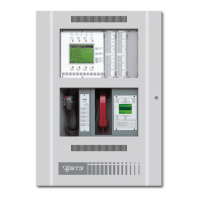System overview
1.16 EST3 Installation and Service Manual
Digital network subsystem
Network data riser wiring
The network data riser provides the communication path
between each CPU module (3-CPUx or 3-ANNCPUx) installed
in the system. Each CPU module has two bi-directional RS-485
ports (Network A and Network B) that are used to connect the
network data riser wiring. Network B is isolated from ground
and Network A is not.
The correct method for running the network data riser is to
connect the isolated Network B port on one CPU module to the
non-isolated Network A port on another. Any remote CPU
modules connected to a local CPU module’s Network B port is
considered to be downstream from the local CPU module. Any
remote CPU modules connected to a local CPU module’s
Network A port is considered upstream from the local CPU
module.
Additionally, next and previous refer to the order in which
remote CPU modules are electrically connected to a local CPU
module. Previous refers to the remote CPU module whose
isolated Network B port connects to the local CPU module’s
non-isolated Network A port. Next refers to the remote CPU
module whose non-isolated Network A port connects to the local
CPU module’s isolated Network B port.
Note: Since the data traveling the network data riser is
bi-directional, out and in references are used to direct wire
connections.
Class B network data risers
In a Class B network, a break or short in the network data riser
wiring divides the network into separate independent networks.
Panels on the same side of the line fault will communicate with
each other but not with panels across the line fault. Figure 1-10
shows the wiring for a Class B network.

